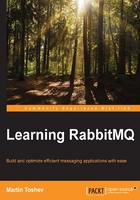
Conventions
In this book, you will find a number of text styles that distinguish between different kinds of information. Here are some examples of these styles and an explanation of their meaning.
Code words in text, names of third-party applications, utilities, folder names, filenames, file extensions andpathnames are shown in bold as follows: "We already saw how easy it is to start/stop/restart instances using the rabbitmqctl and rabbitmq-server utilities that are part of the standard RabbitMQ installation."
A block of code displayed in a box with console font:
<dependency> <groupId>log4j</groupId> <artifactId>log4j</artifactId> <version>1.2.16</version> </dependency>
A block of configuration or output is also displayed in a box as follows:
sudo apt-get install rabbitmq-server –y sudo rabbitmq-plugins enable rabbitmq_management sudo service rabbitmq-server restart
New terms and important words are also shown in bold. Words that you see on the screen, for example, in menus or dialog boxes, appear in the text like this: "Clicking the Next button moves you to the next screen."